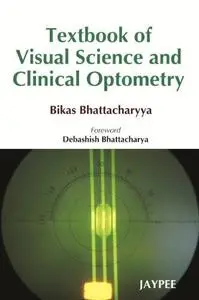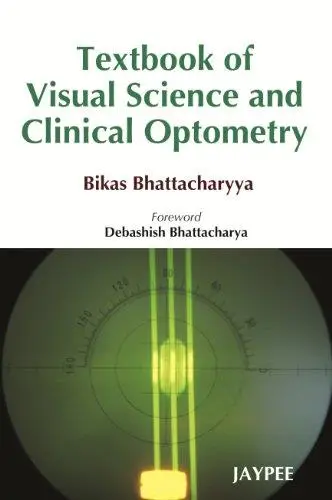Textbook of Visual Science and Clinical Optometry By Bhattacharya
2009 | 316 Pages | ISBN: 8184485999 | PDF | 6 MB
2009 | 316 Pages | ISBN: 8184485999 | PDF | 6 MB
SECTION 1: ANATOMY 1. ANATOMY OF THE EYEBALL * Cornea * Sclera * Limbus * Anterior Chamber * Posterior Chamber * Uveal Tract vii. Retina * Optic Nerve * Lens * Vitreous Humour * Blood Supply of Eyeball 2. ANATOMY OF APPENDAGES OF THE EYEBALL * Conjunctiva * Eyelids * Lacrimal Apparatus * Muscles of the Eye * Levator Palpebrae Superioris 3. ANATOMY OF THE ORBIT * Roof * Medial Wall * Floor * Lateral Wall * Orbital Contents * Superior Orbital Fissure (Sphenoidal) * Interior Orbital Fissure (Sphenomaxillary) * Optic Foramen (Optic Canal) * Surgical Anatomical Spaces within the Orbit SECTION 2: PHYSIOLOGY AND NEUROLOGY OF VISION 4. PHYSIOLOGY OF THE OCULAR STRUCTURES * Aqueous Humour * Vitreous Humour * Cornea * Lens * Tears 5. PHYSIOLOGY OF VISION * Photochemical Changes * Electrical Changes * Visual Perceptions (or Sensations) * Colour Sense 6. THE NEUROLOGY OF VISION * Visual Pathway * Pupillary Pathway * Pupillary Reflexes * Pupillary Reaction Disorders SECTION 3: LIGHT AND OPTICAL PRINCIPLES 7. LIGHT AND HUMAN EYE: BASIC OPTICAL PRINCIPLES * Light and Electromagnetic Spectrum * Basic Optical Principles of Human Eye * Axes and Angles of the Eye * Optical Aberrations of the Eye * Purkinje Images * Retinal Image 8. ACCOMMODATION AND ITS ANOMALIES * Accommodation * Insufficiency of Accommodation * Paralysis of Accommodation * Spasm of Accommodation SECTION 4: REFRACTIVE ERRORS AND CORRECTION 9. ERRORS OF REFRACTION * Hypermetropia * Myopia * Astigmatism * Anisometropia * Aphakiavi. Pseudophakia * Presbyopia 10. ESTIMATION AND CORRECTION OF REFRACTIVE ERRORS * Retinoscopy * Autorefractometry * Photorefraction * Subjective Refraction * Prescription for Spectacles SECTION 5: PRACTICAL OPHTHALMICS AND CLINICAL OPTOMETRY 11. MATERIALSOPHTHALMIC LENS AND SPECTACLE FRAME * Ophthalmic Lens Materials * Spectacle Frame Materials 12. OPHTHALMIC LENSES * Spherical Lenses * Cylindrical Lenses * Unit of Lens Power * Special Types of Lenses * Transposition * Neutralisation (Determination of Power of a Lens) 13. COATINGS AND TINTS OF LENSES *Antireflection Coating (AR Coating) * Tints * Photochromism * Hard Coating/Scratch Resistant Coating * Ultraviolet Inhibitors * Water Resistant/Hydrophobic Coating * Polaroid Lenses * Lens Care and Cleaning 14. FRAMES AND LENSES: DIMENSIONS, MEASUREMENTS AND STYLES * Spectacle Frame Dimensions * Parts of a Frame * Common Terminologies Associated with Frame * Shapes of Frames * Common Types of Frames * Special Types of Spectacle Frames * InformationsAvailable from the Frame * Lens Styles ix. Optical Centre of Lens * Pupillary (or Interpupillary) Distance * Vertex Distance 15. CONTACT LENS * Indications * Advantages Over Spectacles * Optics of Contact Lenses * Scleral Contact Lens * Semiscleral (or Soft or Hydrogel) Contact Lens * Corneal (or Rigid) Contact Lens * Fitting Procedures * Contact Lens Related Informations and Terminologies * Assessment of Soft Contact Lens Fitting * Assessment of Rigid Contact Lens Fitting * Determination of Contact Lens Power * Complications of Contact Lens Wear SECTION 6: SPECIAL CHAPTERS 16. OPHTHALMIC INSTRUMENTATION * Slit-lamp Biomicroscope * Tonometry * Gonioscopy * Indirect Biomicroscopy * Lens Measure (or Geneva Lens Measure) * Keratometer (or Ophthalmometer) vii. Lensometer (or Focimeter) * Direct Ophthalmoscope 17. LOW VISION AND LOW VISUAL AID * Clinical Assessment of a Patient with Low Vision * Management of Patients with Low Vision * Working Principle of Low Visual Aids * Low Visual Devices 18. PAEDIATRIC EYE EXAMINATION * History Taking * Ophthalmic Examination Proper * Clinical Examination of the Eye Proper * MilestonesNormal Visual Maturation and Reflexes * Normal Visual Acuity Maturation (Age-related)



